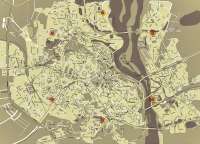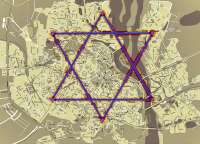This is a project concerning social and institutional critique both. It is the play with the problem of localization of the place where art should happen, but suddenly it appears in another place than it was expected. And also this project reveals conform
Andrei Sidorkin Unseen Connections This is a project concerning social and institutional critique both. It is the play with the problem of localization of the place where art should happen, but suddenly it appears in another place than it was expected. 1. The essence of the project. Event takes place in the city of Kiev. Six musicians are located in six different areas of the city: one in each district. These musicians make up a band. For example: a guitarist, a drummer, a bass player, a keyboard player, a saxophonist, a trumpeter. Musicians can hear each other via the headphones connected to the mobile network. At a certain predetermined time they begin to play a musical piece (most likely Gershwin's one), each musician plays his own part. And pedestrians seem to consider a single part played separately by each musician rubbish, as they do not hear the whole piece played by a full band. Each musician is to be recorded on video and audio media. 2. The next stage is an exhibition of documentation. On six monitors that are put side by side an exhibition visitor can see a record of the musicians’ performing and hear them as if they play in the same place. One can also find there the city map depicting the arrangement of musicians. And besides that, there is a text material that explains the event in a banal, as a matter of fact, but inspiring way: every human being plays his or her own role, own part in the city life. This part may look odd and senseless at first glance but in fact it represents an integral part in a “big city music”. 3. However, when a visitor is leaving an exhibition place for their daily routine and coming across the project seems to be over, some stranger standing near the exit outside the exhibition gives them a leaflet. This leaflet is to be made in that recognizable style of anti-Semitic printings, which are well-known to almost every inhabitant of the former Soviet Union. A visitor learns from this leaflet that the scheme of musicians’ location on the Kiev map replicates the form of King David’s star (it appeals to a great number of domestic conspiracy theories, e.g. the one that insists on the fact that the Moscow metro lines repeat the shape of 6-pointed star etc). So the musicians’ cooperation appears as a metaphor of Zionist’s conspiracy and reproduces the common places of anti-Semitic rhetoric: all the Jews are connected with some kind of common invisible net, if one Jew knows something, another one being at the other point of populated universe knows the same and all the world “dances to their tune”. Thus, the composition of this project represents the very model of relations which are developed by the follower of conspiracy theory. Some sort of meta-story is being added to an existing description of social reality. It presents an evident state of affairs as a malicious trickery with criminal purpose. And this person itself believes he speaks from outside of this evidence, he claims to be beyond the territory of social convention. This project is especially relevant in Ukraine, where anti-Semitic traditions are particularly strong. The “Jewish theme” is awkward here and it is doubtful whether some institution would agree to work with it giving the preference to banal but more “safe” project. That’s why in accordance with the “conspiracy” structure of the project even the institution that grants it shouldn’t know about its third stage till the last moment.
This is a project concerning social and institutional critique both. It is the play with the problem of localization of the place where art should happen, but suddenly it appears in another place than it was expected. And also this project reveals conform
Andrei Sidorkin Unseen Connections This is a project concerning social and institutional critique both. It is the play with the problem of localization of the place where art should happen, but suddenly it appears in another place than it was expected. 1. The essence of the project. Event takes place in the city of Kiev. Six musicians are located in six different areas of the city: one in each district. These musicians make up a band. For example: a guitarist, a drummer, a bass player, a keyboard player, a saxophonist, a trumpeter. Musicians can hear each other via the headphones connected to the mobile network. At a certain predetermined time they begin to play a musical piece (most likely Gershwin's one), each musician plays his own part. And pedestrians seem to consider a single part played separately by each musician rubbish, as they do not hear the whole piece played by a full band. Each musician is to be recorded on video and audio media. 2. The next stage is an exhibition of documentation. On six monitors that are put side by side an exhibition visitor can see a record of the musicians’ performing and hear them as if they play in the same place. One can also find there the city map depicting the arrangement of musicians. And besides that, there is a text material that explains the event in a banal, as a matter of fact, but inspiring way: every human being plays his or her own role, own part in the city life. This part may look odd and senseless at first glance but in fact it represents an integral part in a “big city music”. 3. However, when a visitor is leaving an exhibition place for their daily routine and coming across the project seems to be over, some stranger standing near the exit outside the exhibition gives them a leaflet. This leaflet is to be made in that recognizable style of anti-Semitic printings, which are well-known to almost every inhabitant of the former Soviet Union. A visitor learns from this leaflet that the scheme of musicians’ location on the Kiev map replicates the form of King David’s star (it appeals to a great number of domestic conspiracy theories, e.g. the one that insists on the fact that the Moscow metro lines repeat the shape of 6-pointed star etc). So the musicians’ cooperation appears as a metaphor of Zionist’s conspiracy and reproduces the common places of anti-Semitic rhetoric: all the Jews are connected with some kind of common invisible net, if one Jew knows something, another one being at the other point of populated universe knows the same and all the world “dances to their tune”. Thus, the composition of this project represents the very model of relations which are developed by the follower of conspiracy theory. Some sort of meta-story is being added to an existing description of social reality. It presents an evident state of affairs as a malicious trickery with criminal purpose. And this person itself believes he speaks from outside of this evidence, he claims to be beyond the territory of social convention. This project is especially relevant in Ukraine, where anti-Semitic traditions are particularly strong. The “Jewish theme” is awkward here and it is doubtful whether some institution would agree to work with it giving the preference to banal but more “safe” project. That’s why in accordance with the “conspiracy” structure of the project even the institution that grants it shouldn’t know about its third stage till the last moment.

